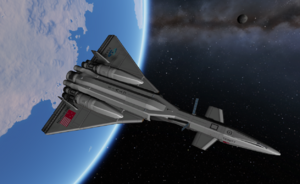Aries Crew Transfer Vehicle: Difference between revisions
No edit summary |
No edit summary |
||
| Line 53: | Line 53: | ||
The '''Aries Crew Transfer Vehicle''' (CTV) is a class of [[Meridon|Meridonian]] fully-reusable, {{wpl|Single-stage-to-orbit}} spaceplanes operated primarily by the [[Federal Spatial Advancement Administration]], with a single model operated by the [[Meridon Air Forces]] for clandestine missions. Its program and official name, the Crew Transfer Vehicle, is indicative of its purpose primarily as a low orbital transfer vehicle, however it is capable of small payload deliveries to low orbit. | The '''Aries Crew Transfer Vehicle''' (CTV) is a class of [[Meridon|Meridonian]] fully-reusable, {{wpl|Single-stage-to-orbit}} spaceplanes operated primarily by the [[Federal Spatial Advancement Administration]], with a single model operated by the [[Meridon Air Forces]] for clandestine missions. Its program and official name, the Crew Transfer Vehicle, is indicative of its purpose primarily as a low orbital transfer vehicle, however it is capable of small payload deliveries to low orbit. | ||
Design and development for what would become the Aries and the [[Hercules Shuttle | Design and development for what would become the Aries and the [[Hercules Orbital Cargo Shuttle]] began in the early 1980s as a proof of concept by independent researcher Levi Pelesa, and later his wife, Ashley. Both hired by [[Laurein Aerospace]]'s Space Launch division in 1985 as engineers, Laurein pitched the concept to the FSAA in 1986 as a radical solution following the impending retirement of the Whiteflash series of launch vehicles for human spaceflight, proposing radically reduced costs per launch, higher flight availability, and the ability to operate using reduced infrastructural costs. The project was one of the most expensive government-funded projects in the history of Meridon, with development costs- particularly for the engine systems, which ran in excess of one trillion dollars over its lifespan in total and required the involvement of Marquesan assistance in development. Conducting atmospheric and ground test flights and operations throughout the mid to late 2010s, the first development shuttle, ''Aries'', conducted a suborbital and then orbital flight in 2019. | ||
Aries shuttles, alongside the Hercules cargo transports, form the backbone of Meridonian space exploration capability. Five have been built, with four in active service with the FSAA. A fifth was built as a mockup, static reference and for spare parts. | Aries shuttles, alongside the Hercules cargo transports, form the backbone of Meridonian space exploration capability. Five have been built, with four in active service with the FSAA. A fifth was built as a mockup, static reference and for spare parts. | ||
Revision as of 00:47, 19 November 2023
| Aries Crew Transfer Vehicle | |
|---|---|
 Aries M4 Trinity (CTV-3) in LEO during OM-14. | |
| Type | Reusable SSTO crew and cargo carrier |
| Owner | Federal Spatial Advancement Administration |
| Manufacturer | Laurein Aerospace |
| Specifications | |
| Dry mass | 328,800lbs |
| Launch mass | 528,426lbs (full fuel, no payload) |
| Communication | test |
| Rocket | Turboramjet and SABRE engines |
| Instruments | |
| |
| History | |
| First flight |
|
| Fate | Active service, 5 built |
The Aries Crew Transfer Vehicle (CTV) is a class of Meridonian fully-reusable, Single-stage-to-orbit spaceplanes operated primarily by the Federal Spatial Advancement Administration, with a single model operated by the Meridon Air Forces for clandestine missions. Its program and official name, the Crew Transfer Vehicle, is indicative of its purpose primarily as a low orbital transfer vehicle, however it is capable of small payload deliveries to low orbit.
Design and development for what would become the Aries and the Hercules Orbital Cargo Shuttle began in the early 1980s as a proof of concept by independent researcher Levi Pelesa, and later his wife, Ashley. Both hired by Laurein Aerospace's Space Launch division in 1985 as engineers, Laurein pitched the concept to the FSAA in 1986 as a radical solution following the impending retirement of the Whiteflash series of launch vehicles for human spaceflight, proposing radically reduced costs per launch, higher flight availability, and the ability to operate using reduced infrastructural costs. The project was one of the most expensive government-funded projects in the history of Meridon, with development costs- particularly for the engine systems, which ran in excess of one trillion dollars over its lifespan in total and required the involvement of Marquesan assistance in development. Conducting atmospheric and ground test flights and operations throughout the mid to late 2010s, the first development shuttle, Aries, conducted a suborbital and then orbital flight in 2019.
Aries shuttles, alongside the Hercules cargo transports, form the backbone of Meridonian space exploration capability. Five have been built, with four in active service with the FSAA. A fifth was built as a mockup, static reference and for spare parts.
Design and Development
Operational history
Mission profile
Systems
SABRE engine
The Selectively Air-Breathing Rocket Engine (SABRE) is a dual-function rocket engine capable of using both atmospheric air in a precooled afterburning turbojet engine, and liquid oxygen in a closed-cycle traditional rocket engine.



